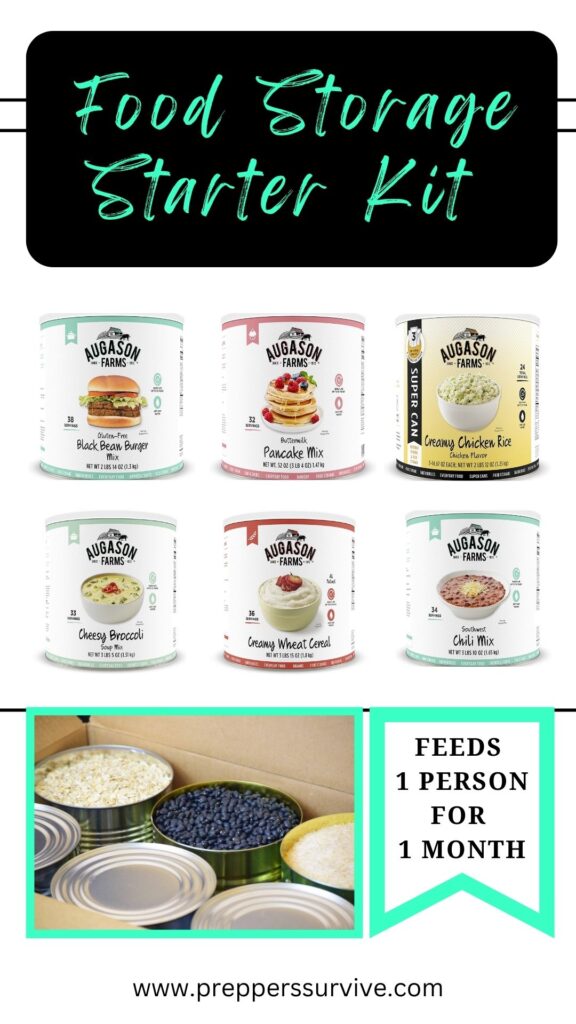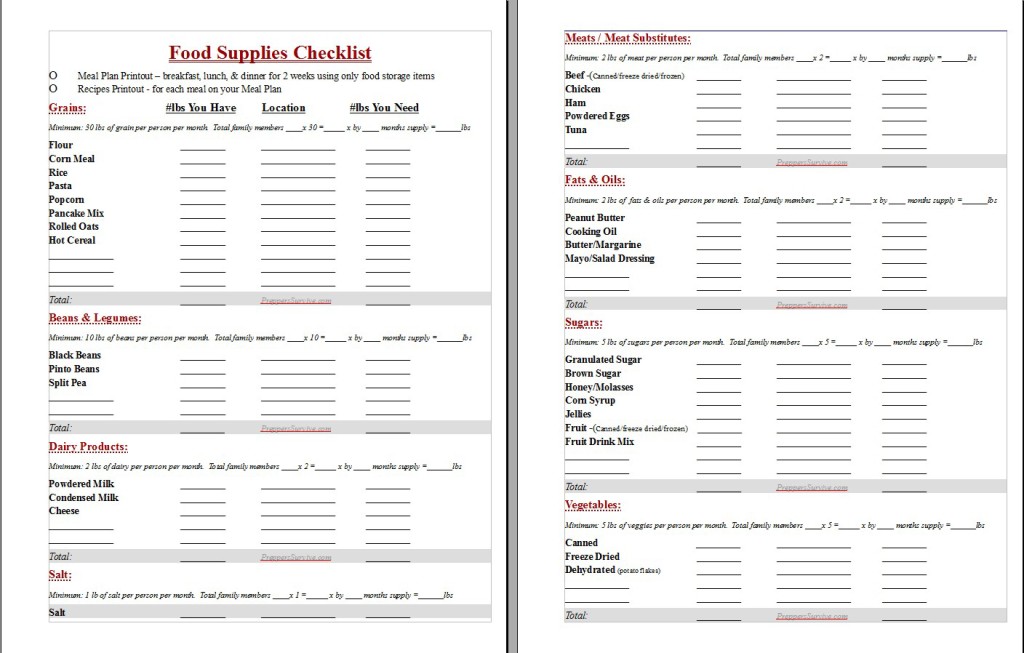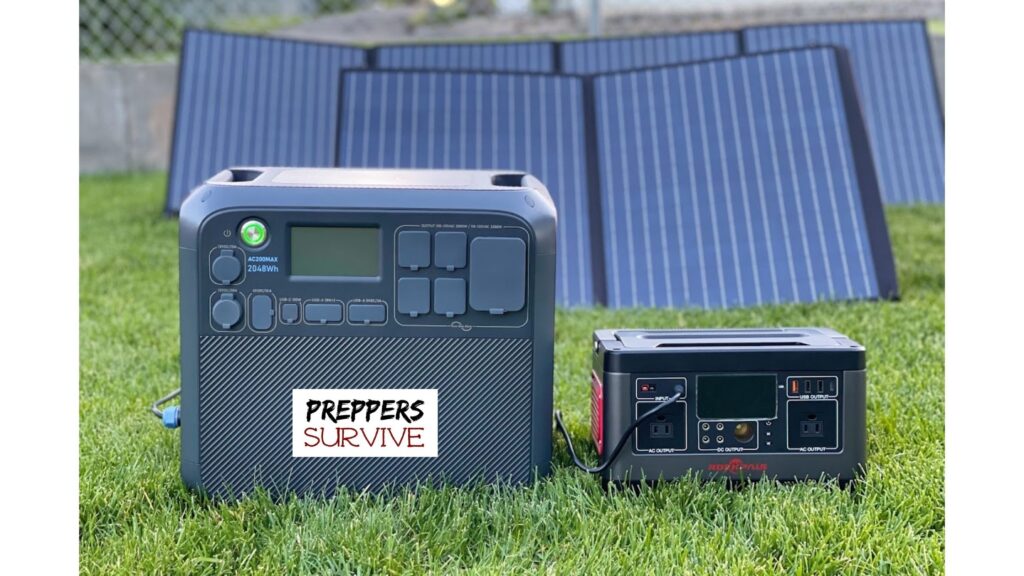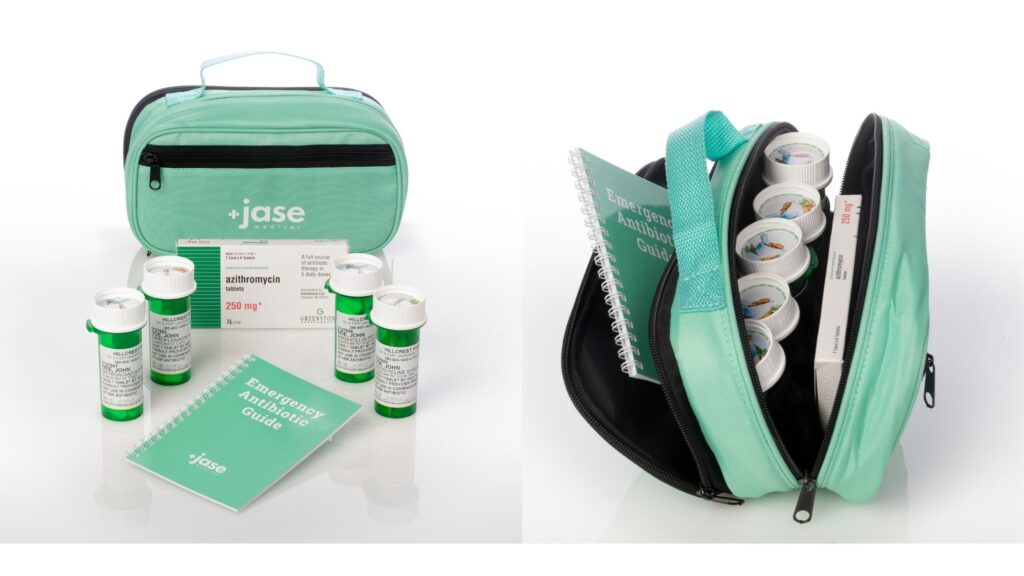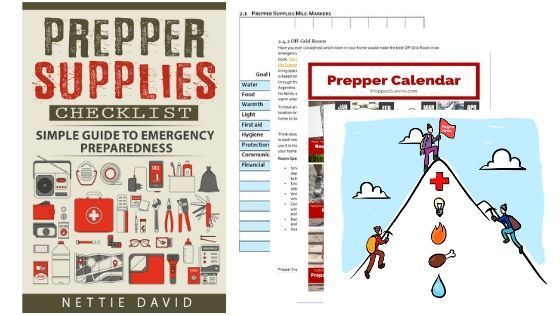Prepping to survive means having some supplies set aside to sustain you through a natural disaster, pandemic, wartime, or economic upheaval. That’s where prepping resources come in handy.
Preppers know that disasters, emergencies, and food shortages can strike at any time. And when they do, there will be little to no time to prepare for the upcoming emergency.
And when the rest of the neighborhood is clamoring for the same scant supplies — emergency heaters, solar-powered lighting, nonperishable food, and other essential supplies — the last thing you would want is to be empty-handed.
10 Ways to Start Prepping
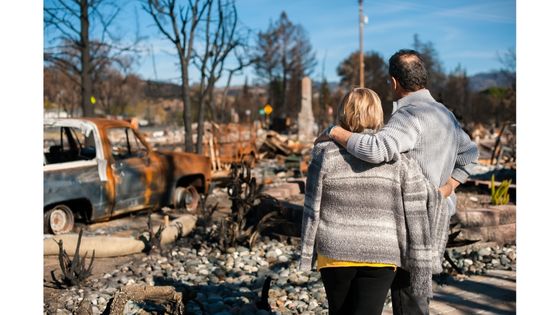
When you prepare for an emergency, there’s more to it than just gathering supplies. An important part of emergency preparedness is having an idea of what to do in different emergency situations and knowing how to stay safe. Contrary to popular belief, emergency preparedness is not always for doomsday scenarios. Preparing for an emergency can be helpful in weather-related events, power outages, and many more.
1. Know what disasters to expect
Research the history of the area you live in to understand what types of emergencies or natural disasters are prone to happen. These could be tornadoes, hurricanes, earthquakes, chemical spills, drought, wildfires, etc. Also, consider current events like the threat of war, inflation, recession, employment rate, food deserts, and pandemics. Once you are aware of what disasters to expect, you can start preparing for them well. This will help you understand what supplies to gather and plans to make.
For example, if you live in an area that is prone to hurricanes, you will need to plan what to do if one hits. This plan should include a month’s worth of supplies to shelter in place, where you’ll go if evacuation is necessary, how you’ll get there, and what you’ll need to bring.
2. Memorize prepping categories
Prepping can be overwhelming, but it doesn’t have to be. One way to make the process less daunting is to memorize prepping categories. This will help you focus on gathering the supplies you need without getting sidetracked.
There are six main categories you should prep for, such as:
- Water
- Food
- Warmth/Shelter
- Light/Power
- First Aid
- Hygiene
- Communication
- Protection
- Financial
3. Have a plan in place and practice accordingly
Once you know what disasters to expect and you’ve gathered supplies, you need to make a plan. Your family members or household should be aware of the plan and understand their role in it. To do so, you should practice the plan and ensure everyone knows what to do to avoid confusion during evacuation or emergencies. This will help things go more smoothly if there’s ever an emergency. If you’re not sure where to start, you can check out these prepper resources:
4. Get Connected
A good way to prepare for an emergency is by staying connected. This requires you to stay up-to-date on the latest information and alerts. There are various ways you can get alerts or get involved with your neighborhood’s emergency preparedness efforts.
Here are four things you can do to stay connected:
- Start or join a neighborhood watch, neighbor text chain, or city social media group.
- Sign up for local city alerts.
- Set up a news feed app with topics you want to be updated on, like disaster prepping.
- Subscribe to survival prepper blogs like this one or join a preppers group on social media.
5. Have a bug out bag
Stores will be crowded, empty, or closed during an emergency. An important step in preparing is having supplies packed in a backpack or a 5-gallon bucket, ready to grab and go. This way, you won’t have to worry about packing during an emergency, and you’ll be among the first to leave town.
Your emergency go bag should include items from the prepping categories mentioned above. Remember to include items such as important documents in case you need them. Place your emergency bag in an easily accessible place, like by the door.
6. Prepare your home
Once you have a plan, consider how to prepare your home. First, you’ll need a place to store your emergency supplies and bug out bag. Next, designate a room in your home as the Off Grid Room or “safe room.” Implement home defense strategies to add a layer of protection. Also, work on fire prevention, like trim trees near your home or power lines. Lastly, determine several escape routes and practice them as part of your evacuation plan.
7. Plan for a power outage (most common need for preps)
Power outages may happen during emergencies due to bad weather, natural disasters, or an EMP. Cold or hot temperatures can cause extreme weather that increases the chances of power outages. Sometimes, power outages can last from hours to days. During disasters, it can last for three weeks. Create a power outage kit.
Power surges can damage appliances and are common in disasters. I had to replace a fridge, toaster, and toaster oven because of a power surge. The fridge and toaster oven acted like they were still working, but then we noticed items going bad in the fridge and the oven taking much longer to heat items up, and by the end of the month, I spent $1200 replacing those three items. Get at least two surge protectors for your kitchen, one for the fridge and one for other appliances. Other things you may want to protect are the TV, DVD, Computer, printer, stand-up freezer, and lamps.
8. Stock up on food and emergency supplies
When disaster strikes, you may not be able to leave your home or head to the store to grab anything. That’s why it’s imperative that you have enough food and supplies to last for a while. This is where the prepping categories come in handy. Decide what supplies you want in each of the categories. Here is a comprehensive prepper checklist PDF.
It’s a good idea to stock up on non-perishable food items that don’t require cooking, like granola bars or peanut butter. A manual can opener is a handy tool to have during emergencies. This is useful if you stock up on canned food.
9. Store your emergency preps properly.
If you go through all the trouble of getting emergency supplies, store them properly! Food and water should always be kept in a cool, dry place and sealed in air-tight containers. It’s important to remember to rotate your food and water storage. Organize your other preps, so they are easy to locate when needed. Check out this social media comment from Gloria, who was in the path of Hurricane Ivan and will make organizing preps a prior in the future. [We are rooting for you, Gloria! So glad you and your family are safe!!]
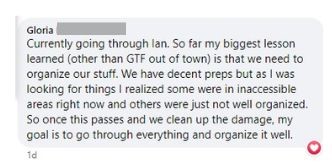
10. Choose a self-reliant skill to develop.
A self-reliant skill can be beneficial during an emergency since you never know when you might need it. For example, if you know how to do something like fix a car or change a tire, then that can come in handy if your car breaks down or gets a flat tire.
What are some survival prepping skills? Here are ten skills you can start developing today:
- Gardening
- Raising chickens, rabbits, or starting a worm farm
- Hunting
- Fishing
- Canning
- Learn how to use a compass
- Self-defense techniques
- Get a ham radio license
- Getting CPR certified
- Learn how to operate a generator safely
Wrapping Up
If you want to be prepared for an emergency but aren’t sure where to start, these ten tips are great for introducing yourself to survival prepping. Don’t hesitate to take the time to plan and prepare now. Disaster prepping takes time, a plan, and prepper resources. Below are some tips to help you add to your emergency supplies.
– – – – – – – – – – – – – – – –
Prepper Resources
Water
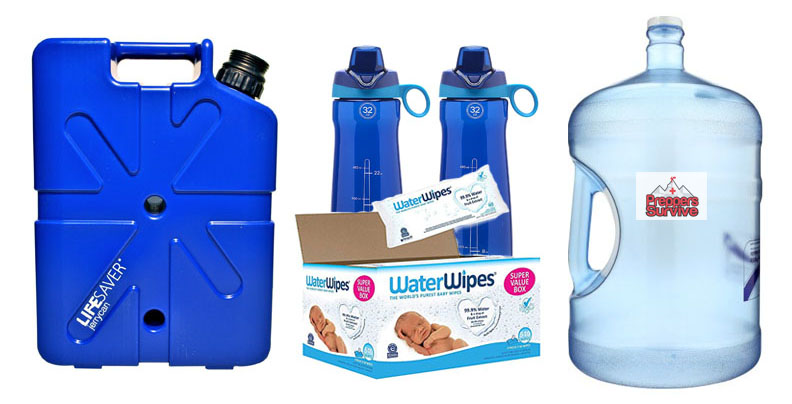
How much water storage do I have for my family? The survival prepping rule is a minimum of one gallon of water per person per day. Be mindful that rationing may be required. For my family, I store 10 gallons per person using blue 5-gallon jugs (seen in the photo below), so it would ideally last us at least 10 days. Each member also has a hiking water filter and their own water bottle. The water bottle has the ounces marked on it, which helps us to monitor how much water each person is drinking and saves us from washing cups. Along with small camping water filters, our preps also include a large jerrycan water filter that removes contaminates found in rivers. We live very close to a river and can easily collect water whenever we need more. Another prep that we find useful is Water Wipes, so we don’t have to use precious water for hygiene and washing dishes. Related article: Is it safe to drink old water storage?
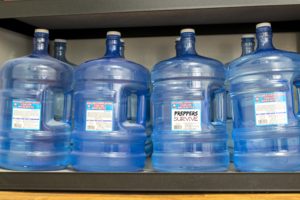
– – – – – – – – – – – – – – – – – – – – – – – – – – –
Food
The photo above is a free printable survival prepping resource to provide ideas on how many pounds of food to stash for each family member. It is broken down into categories and is just a guide. Keeping a log can track how many pounds of food your family actually eats a week, so you’d have a better idea of how many pounds to stock up on. Try to get a month’s worth of food storage. Click on the links below for the prepper resource you are interested in.
Food Supply Printable Checklist
6 Methods to Cook Indoors Without Electricity Safely
Power/Light
How many watts do I need in a generator to power my house?
Here is a worksheet designed by International Conference on Electronic Commerce to answer that question: Wattage Worksheet Link
There is a learning curve when you become a generator owner, especially a diesel or gas generator! Having a backup power source is a game-changer!! However, there is a lot of work to get passed the learning curve for using and providing maintenance to a generator. Diesel and gas generators produce carbon monoxide while they are running. Many people have been hospitalized for carbon monoxide poisoning produced by their generators in an open garage. It’s recommended to operate them ONLY OUTSIDE, far from windows.
Solar generators are simpler to operate. If you are connecting a generator to your home rather than just a refrigerator, then you will need to contact the local power company and other city departments to find out what is legal for your area. You’ll also need a licensed electrician to install a manual transfer switch or an interlock kit. Plugging a generator into your home without the proper electrical system can have dangerous and costly results.
Antibiotics/First Aid Kit
Having antibiotics for the first aid kit is a common goal among preppers. Did you know that generic antibiotics are produced outside of the United States? There are lots of things that can disrupt the supply chain and cause shortages. It’s no wonder people are more eager than ever to have a backup supply of this life-saving medication.
Learn how to get five doctor-prescribed antibiotics from Jase Medical to add to your emergency supplies.
Protection
Protecting yourself and your loved ones from danger is incredibly important, no matter what situation you find yourself in. It is possibly the most overlooked out of the nine prepping categories. In the case of a natural disaster like a hurricane, you need to be prepared for anything and anyone who might cause you harm. A self-defense weapon you’ve been trained to use can add to your sense of safety.
This video was created by Urban Survivor. Check out some of their other videos, and don’t forget to subscribe.
Financial Survival Prepping
Unfortunately, evacuees deal with thieves. Displaced people need to have money to purchase supplies and find lodging. Secret hiding containers can keep valuables safe. A concealment stash comes in the form of a hollowed-out book, a fake shaving cream container, a secret compartment of a hairbrush, the back of a photo frame, or an insulated water bottle with hidden space. It is unwise to carry $10,000 in cash or more. However, only you can guess how much you’ll need. Companies like PayPal have been a good place to hold your money if you are unsure about local banks.
Free Prepper Resource: How to make a Diversion Safe
Survival Prepping
=================
Want a more detailed Emergency Supplies Checklist with specific lists in nine categories? You can find it on Amazon.
Prepper
– – – – – – – – – – – – – – – – – – – – – – – – – – – –
Thanks for visiting Preppers Survive. Before you leave subscribe to our newsletter. If you enjoyed this article on survival prepping, please share it on your favorite social media.
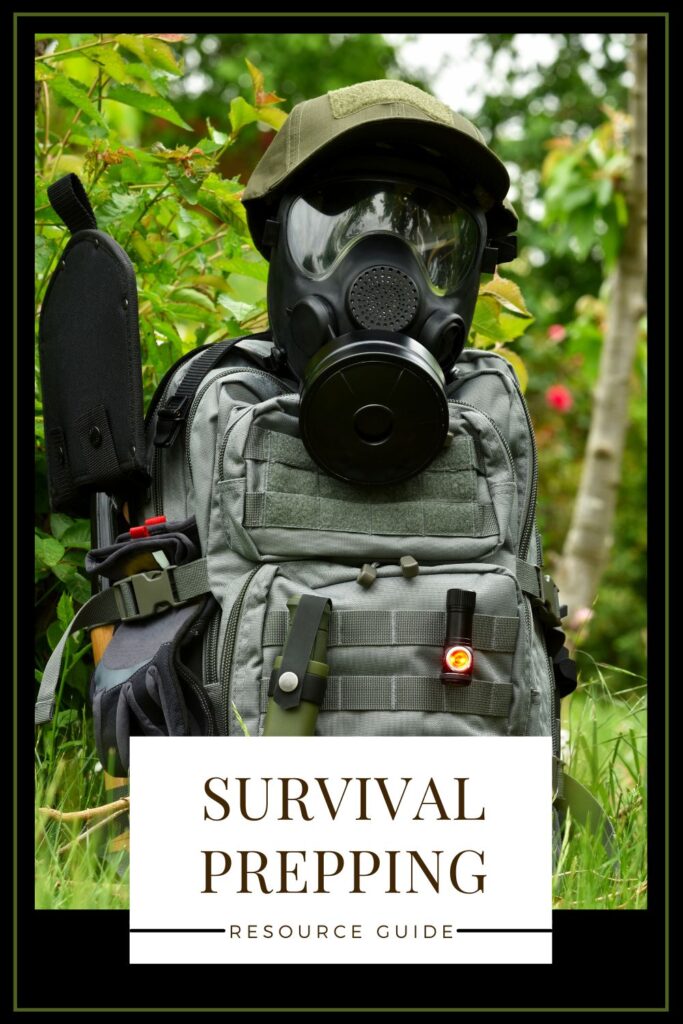
Subscribe below if you would like to receive emails for prepper articles and resources.


